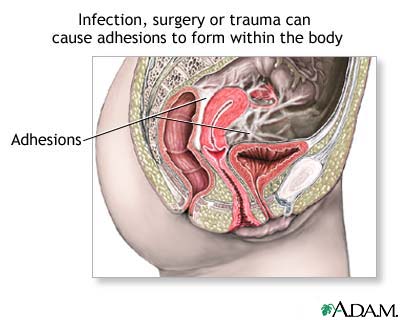Treatment
Surgery may be done to separate the adhesions. This often allows normal movement of the organ and reduces the symptoms caused by the adhesion. However, the risk for more adhesions increases as the number of surgeries increases.

Depending on the location of the adhesions, at the time of surgery a barrier can be placed to try to reduce the chance of the adhesions returning.
See also: Intestinal obstruction repair
Prognosis (Expectations)
The outcome is usually good.
Complications
Depending on the tissues involved, adhesions can cause various disorders.
* In the eye, adhesion of the iris to the lens can lead to glaucoma.
* In the intestines, adhesions can cause partial or complete bowel obstruction.
* Adhesions inside the uterine cavity, called Asherman syndrome, can cause a woman to have irregular menstrual cycles and be unable to get pregnant.
* Pelvic adhesions that involve scarring of the fallopian tubes can lead to infertility and reproductive problems.
* Abdominal and pelvic adhesions can cause chronic pain.
Calling Your Health Care Provider
Call your health care provider if you have:
* Abdominal pain
* An inability to pass gas
* Nausea and vomiting that do not go away
* Pain in the belly that is severe and crampy
Adhesion: Overview, Causes
Adhesion: Symptoms & Signs, Diagnosis & Tests
Adhesion: Treatment
Reviewed By : Susan Storck, MD, FACOG, Chief, Eastside Department of Obstetrics and Gynecology, Group Health Cooperative of Puget Sound, Redmond, Washington; Clinical Teaching Faculty, Department of Obstetrics and Gynecology, University of Washington School of Medicine. Also reviewed by David Zieve, MD, MHA, Medical Director, A.D.A.M., Inc.
